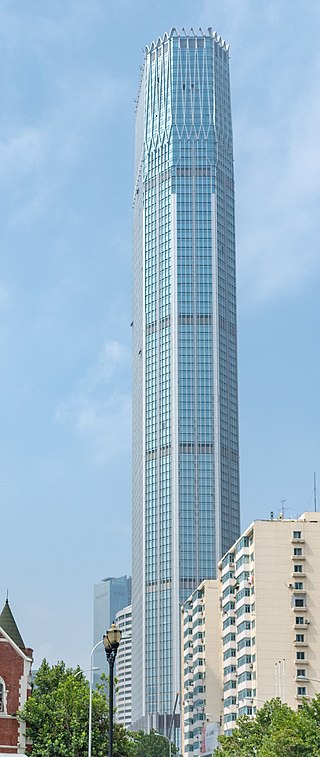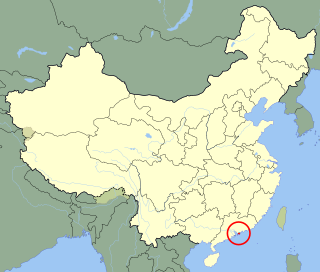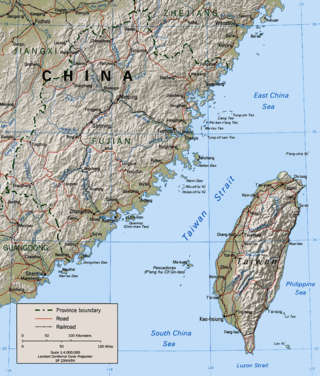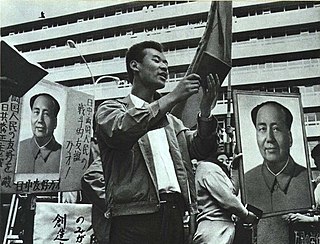
Guomao is an area in Beijing at the center of the Beijing central business district, demarcated by the intersection of Jianguomen Outer Street and the Third Ring Road. The Chinese World Trade Center is located there. It was formerly known as Dabeiyao, and bus stops in the vicinity still bear this name.

The Dalian International Trade Center is a supertall skyscraper designed by architecture firm HOK in Dalian, Liaoning, China.
The China Council for the Promotion of International Trade is a trade body founded in 1952. It also goes by the name of the China Chamber of International Commerce. CCPIT is controlled by the Ministry of Commerce.

Liao Chengzhi was a Chinese politician. He joined the Communist Party of China in 1928, and rose to the position of director of the Xinhua News Agency; after 1949, he worked in various positions related to foreign affairs, most prominently president of the Beijing Foreign Languages Institute, president of the Sino-Japanese Friendship Society, and Minister of the Office of Overseas Chinese Affairs.

Tatsunosuke Takasaki was a Japanese businessman-politician.

Tianjin Free-Trade Zone, officially China (Tianjin) Pilot Free-Trade Zone is a free-trade zone in Tianjin, China. It is the only free-trade zone in North China. The zone covers three areas — Tianjin Airport Economic Area, Dongjiang Free Trade Port Zone and Binhai New Area Central Business District.

Guangdong Free-Trade Zone, officially China (Guangdong) Pilot Free-Trade Zone is a free-trade zone in Guangdong province, China. It is a free-trade zone near Hong Kong and Macau. The zone covers an area of 116.2 square kilometres and integrates three existing bonded zones in four areas — Nansha New Area in Guangzhou, Qianhai and Shekou Industrial Zone in Shenzhen and Hengqin Subdistrict in Zhuhai.

Counter-Japanese Military and Political University, also commonly known as Kàngdà (抗大) and Kangri Junzheng University (抗日军政大学), was a comprehensive public university located in Yan'an, Shaanxi, the headquarters of the Chinese Communist Party during the Second Sino-Japanese War. Its former site has been converted to a memorial hall.

Jiangsu Shagang Group Huaigang Special Steel Co., Ltd. is a Chinese steel manufacturer based in Huai'an, Jiangsu Province. It was a subsidiary of privately held company Shagang Group via its publicly traded subsidiary Shagang Company for 63.79% stake, from 2010 to 2015. As at 31 December 2013, Huaigang accounted for 99.9% revenue and 97% assets of Shagang Company. However, as at 31 December 2015, Shagang Group owned just 19.88% stake in Shagang Company; in turn Shagang Company owned 63.79% stake of Huaigang. Shagang Group sold 55.12% stake of Shagang Company in 2015, for about ¥4.6 billion RMB.

Xiong'an New Area is a state-level new area in the Baoding area of Hebei, China. Established in April 2017, the area is located about 100 kilometres (62 mi) southwest of Beijing and 50 kilometres (31 mi) east of downtown Baoding. Its main function is to serve as a development hub for the Beijing-Tianjin-Hebei (Jingjinji) economic triangle. Additionally, "non-core" functions of the Chinese capital are expected to migrate here, including offices of some state-owned enterprises, government agencies, and research and development facilities. The city is planned to be erected by 2035, and completed by 2050, where according to guidelines, is aiming to be a high-level socialist modern city that will be environmentally friendly and be connected by high-speed rail network that will take 20 minutes to travel to the new Beijing airport and 30 minutes to Beijing and Tianjin.

The constitutional oath of office of China was implemented on January 1, 2016 through a decision by the Standing Committee of the National People's Congress of China. The oath requirement applies to state civil servants elected or appointed by the National People's Congress and its Standing Committee at or above the county level.
Zeng Shiqiang was a Chinese sinologist best known for studying I Ching, the oldest of the Chinese classics. Zeng is acclaimed as having been the "Father of the Chinese Style of Management". He served as president of Hsing Kuo University of Management (HKU) and professor at National Chiao Tung University (NCTU).

Jiang Xiaojuan is a Chinese economist and politician. She is a Professor and Dean of the School of Public Policy and Management of Tsinghua University, and a research professor at the Chinese Academy of Social Sciences (CASS). She is a Standing Committee Member of the National People's Congress (NPC) and Vice Chairperson of the NPC Social Construction Committee, taking charge of lawmaking, revision, enforcement, and supervision of social insurance, sports, protection of women's and children's rights and others. She was elected President of the Chinese Public Administration Society in 2019.

Hong Kong–mainland China relations refer to the relationship between Mainland China and Hong Kong. According to the 1997 Sino-British Joint Declaration, the United Kingdom handed control of Hong Kong over to the People's Republic of China, making it a special administrative region. In principle, Hong Kong became an autonomous administrative division based on the Hong Kong Basic Law.

China Central Depository & Clearing Co., Ltd., in short CCDC or ChinaBond, is a central securities depository for Chinese government bonds, based in Beijing.
Akinobu Kuroda(黑田明伸) is professor of East Asian history in the Institute for Advanced Studies on Asia, University of Tokyo. He specialises in the complementarity of monies in East Asia, India, Africa, and Europe.

The Fujian–Taiwan relations, also known as the Min–Tai relations, refers to the relationship between Fujian, which is located in mainland China, and Taiwan, which is across the Taiwan Strait. Since the average width of the Taiwan Strait is 180 kilometers, Fujian and Taiwan are adjacent, similar in both climate and environment. Although the relationship between Taiwan and Fujian has changed with the development of history, the two places have maintained close relations in terms of personnel, economy, military, culture and other aspects. At present, Taiwan residents are mostly descendants of immigrants from mainland China, of which the southern Fujian ethnic group is the main group, accounting for 73.5% of Taiwan's total population. In terms of culture, language, religion, and customs, Fujian and Taiwan also share similarities.

Mao Zedong, the longtime Chairman of the Chinese Communist Party and the founder of the People's Republic of China, was reported to have expressed his gratitude to the Japanese military and political figures who visited China in the 1950s and 1970s. Mao said that the Japanese invasion of China had united Chinese people and allowed the Chinese Communist Party to win the Chinese Civil War. In the 21st century, these remarks by Mao caused strong reactions on the internet in China. With the 2020 Hong Kong Diploma of Secondary Education Examination (HKDSE) history subject controversy on the historical understanding of Japan's invasion of China, these remarks have returned to the spotlight on Hong Kong and mainland Chinese websites. The word "thanks" expressed by Mao has been also interpreted by some observers as dark humour.

China and San Marino established consular-level relations on 6 May 1971 and ambassador-level relations on 5 July 1991.
The history of Cross-Strait relations introduces the historical changes in the relationship between China and Taiwan since the beginning of time. Suspected records of Taiwan in the history of China date back to the earliest times, when Yizhou (island) was mentioned in the "Three Kingdoms", or Liuqiu in the "Book of Sui". During the Song dynasty and Yuan dynasties, there was trade between the two sides of the Strait, and in 1281, Kublai Khan established the Penghu Inspection Division, which began to exercise administrative jurisdiction over Penghu. In 1349, Wang Dayuan documented in Island Yi Zhi Lu that Penghu belonged to Jinjiang County, Quanzhou, and that Liuqiu was one of the overseas countries. The "Dongfan Ji", written by Chen Di in the Ming Dynasty, depicts the customs of the aborigines in southwest Taiwan. Since the 1620s, cross-strait relations have been influenced by the Dutch, the Spanish, the Han Chinese, the Manchus, and the Japanese, and mainland China and Taiwan have either unified or separated, with ups and downs.